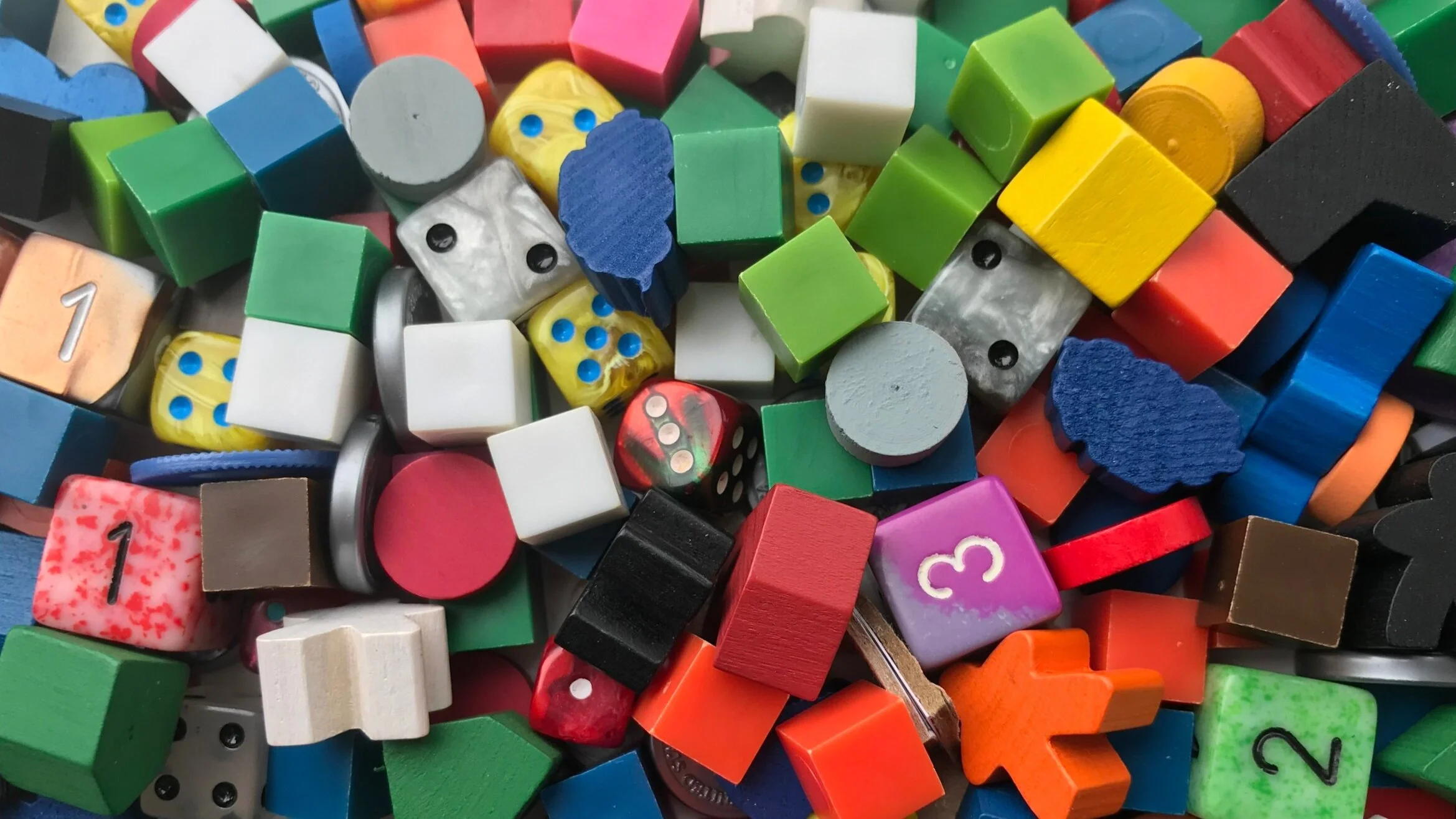Meaningful Decisions: Corey Young on Board Game Design Choices
/In our Meaningful Decisions series, we ask designers about the design choices they made while creating their games, and what lessons other designers can take away from those decisions.
In this edition, we talk with Corey Young, the designer of Gravwell: Escape from the 9th Dimension, about catchup mechanisms, balancing games, and hidden vs. public information.
You’ve said that the way Gravwell mimics gravity–movement is based on proximity and position relative to other players–emerged as you experimented with catchup mechanisms. What did your experiments teach you? Did you try anything that didn’t work as you’d expected?
Initially, I considered using the number of ships in each direction, thinking that it would be easier to compute that than counting the spaces. I found that in actual play, it just wasn’t very compelling. The clustering of the ships was always too tight and, ultimately, less interesting. Also, the physics geek in me kept arguing that the forces involved were more driven by the proximity than the mass.
As it turns out, most players have no trouble seeing the differences in distance. I kept the rules about moving toward the side with the most ships, but it only applies as a tie-breaker when your ship is equidistant to ships in each direction. I could’ve over-complicated the tie-breaker rules to take into account the distance to the next ships, but I chose to keep it as simple as possible.
I also knew that having only cards that draw you closer to other ships would make the clustering too tight. At the highest level, the game would look like a swarm of ships inching gradually forward. The gravitational entanglement of the ships delivers the easy catch-up experience I was after, and it mitigated the run-away-leader problem, but it did the latter to a fault. I felt that if you are able to get yourself out in front of the pack, you should still have some way to extend your lead. I introduced the 4 repulsing cards to balance this.
Did your process developing the catchup mechanic teach you any broadly applicable “truths” or lessons that you or other designers can keep in mind for other designs?
Considering the many catchup mechanisms used in the games I researched, about the only universal truth I could find is that most players simply don’t like catchup mechanisms. The worst are the “long ladders” that can be exploited not only by players in last place, but by any player lucky enough to draw the right card or land on the correct space. Equally frustrating are automatic or random “long chutes” that target leaders.
It occurred to me that the frustration is highest when you are trailing because of individual bad luck on your part or good luck on the part of the leading players, completely or largely independent of the decisions being made during the game. If the luck components of the game are shared among players, like the dice rolls in Macao, then the sting is not so severe. If I end up in last place because I chose a risky strategy, then I don’t mind so much, especially if there are ways to recover.
A lesser catchup mechanism that I built into Gravwell is the last-place-drafts-first rule. At the start of each round, the player in last place gets to draft her cards first, followed by the next-to-last player and so on. This may seem like a pretty heavy-handed catchup mechanism, but it is offset by the fact that player position can sway so quickly. As the swarm of ships move closer to the warp gate, experienced players will actually vie to get into last place at the end of a round in order to gain the first draft advantage. It’s a choice they make, trading temporary position disadvantage for well-timed draft advantage.
The fuel cards in Gravwell are balanced to offer players certain benefits in exchange for certain risks. For example, cards that resolve early–and thus offer greater certainty–tend to only provide limited movement. What was the process of balancing the game’s cards like, and what should other designers keep in mind as they work to balance their games?
The distribution of the amplitudes, the distance the card moves your ship, among the cards did take some tuning, but most of it was clear to me when I started out. I knew that the cards early in the alphabet would be more valuable because you can be more certain of your relative position when they trigger, so I kept their relative amplitudes low.
I originally thought that I should put the highest values near the end of the alphabet, but then I realized that the biggest uncertainty is right near the middle. This is why the biggest card, the 10, is the M. The biggest repelling card, the -6, is on the N.
I also knew that the repelling cards were very valuable in the end game. I wanted to avoid the situation in which a player had an automatic win if they were in the right spot and had the right card down the home stretch. I put the repelling cards later in the alphabet. One thing that did change from my original prototype was the N card. It was originally a 9 instead of a 6. Cryptozoic’s playtesters discovered that it quite often led to the winning move, so we dropped it to 6.
The J and the Q cards are another story. These cards don’t move your ship at all. Instead, they attract all the other ships toward your ship. The distribution of these were a fluke. As it turns out, there are no chemical elements that begin with J or Q. I thought that if I’m making up the elements, I might as well make them special. The Q was raised from 1 to 3 during playtesting. These cards were intended to jumble the field a bit, and they do, but one of their key benefits is actually the ability to sit still for a hand.
Probably the biggest breakthrough was the Emergency Stop card. I wanted to balance the decision-driven action, and I just felt that the players still didn’t quite have enough control over their actions. I now love watching players debate internally on the second hand of a round, considering whether it makes more sense to burn their stop card now later in the round.
Do you think the balancing period for Gravwell is similar to other designs? Does every design present its own unique balancing issues, or are there some things that are universal?
It’s hard for me to gauge this. I tend to iterate my designs very quickly, updating them weekly, and sometimes with a Sharpie marker during a single playtest session.
I’m sure it’s easier for me, simply because I don’t design larger games. I’m amazed at the breadth and depth of the options and combinatorial variety featured in my friends’ designs. I have no insight or wisdom when it comes to balancing such complex games. I’m confident that my “fail fast and fix it” approach doesn’t scale.
In Gravwell, players draft cards in piles that are half face-up and half face-down. This results in a mix of public information and hidden information. How did you settle on this mix? How do different mixes affect player behavior?
In the original prototype, the rules said to deal each player 3 cards, then perform the draft with single (number of players X 3) cards. The standard draft listed in the final rules provides the exact same outcome, but in a much more elegant way. I credit Matt Hyra from Cryptozoic for this and most of the other refinements I’ve mentioned.
I enjoy playing the “no secrets” variation with experienced gamers. The draft works the same way, but all cards are dealt face up. The piles still have two cards each, but the top cards are placed askew so that both are visible. I don’t actually try to memorize all the cards each player takes, but there are a few that I watch for and I make a mental note of who takes them. With so much information available, this type of draft really inflates the importance of draft order. Not surprisingly, experienced players actually jockey for last place in middle to late rounds in order to ensure that they get better draft priority.
I came up with my favorite draft method after the rules went to the printer. I call it the “house blend” and I often show it when I’m demonstrating the game. The number of piles remains the same, three piles of 2 cards each for each player in the game–e.g. 9 piles for a 3-player game. So assuming you’re like most players, you’ll deal 3 rows with each row having as many piles as there are players. In the first row, deal all piles with 2 cards face down. In the second row, deal all piles with one card down and one card up. In the last row, deal all piles with both cards face up (again, the top card is askew so that both cards in each pile are visible). Each round of the draft, you can choose any pile you like.
In your experience with Gravwell (and your other designs) how do players approach situations differently based on the amount of information the designer gives them? More broadly, how does information affect player behavior?
I tried to strike a balance between known and unknown information in Gravwell. My early versions all featured completely open drafts–all cards face up. Testing revealed that hiding half the draft cards decreased AP and increased accessibility.
I wanted the deck to be “knowable,” meaning that a skilled player could memorize all the values and do a bit of card counting. I added the distribution infographic on the corners of the board to help with this. The unused cards in 2- and 3-player games mitigate much of the card counter’s advantage.
The “no secrets” Gravwell variation is a much different game, especially with experienced gamers. Theoretically, all players know exactly which cards everyone else is holding. Part of the challenge is raw memorization–an area in which I suffer. The more interesting play experience for me is attempting to predict when each player will play the few “interesting” cards I that remember them drafting.










